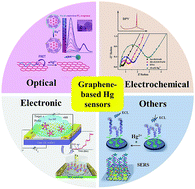Recent advances in sensitive and rapid mercury determination with graphene-based sensors
Abstract
Mercury ions (Hg2+) are the dominant mercury species in water, and have severe toxic effects on human health and the ecosystem. Due to the limitations of traditional analytical methods for mercury determination, e.g., complex pretreatment, costly instruments, and being unsuitable for low-level online sensing, numerous efforts have been made to develop rapid, low-cost, and portable sensors for Hg2+ determination. The excellent characteristics of graphene, i.e., a unique two-dimensional structure, large surface area, high conductivity and carrier mobility, and good optical and electrochemical properties, lead to intense studies on graphene-based Hg2+ sensors with desirable performance and broad application prospects. The scope of this review is recent advances in graphene Hg2+ sensors with a special focus on optical, electrochemical, and electronic sensors. The working principles and advantages of representative graphene Hg2+ sensors are introduced and compared with traditional methods. Moreover, challenges as well as potential solutions and research directions of mercury sensors are discussed, which will guide future research of Hg2+ sensors in biomedical and environmental monitoring applications.

- This article is part of the themed collection: Recent Review Articles


 Please wait while we load your content...
Please wait while we load your content...